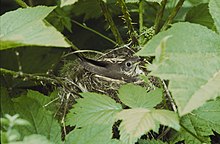

| Gray-cheeked thrush | |
|---|---|

| |
| Scientific classification | |
| Domain: | Eukaryota |
| Kingdom: | Animalia |
| Phylum: | Chordata |
| Class: | Aves |
| Order: | Passeriformes |
| Family: | Turdidae |
| Genus: | Catharus |
| Species: |
C. minimus
|
| Binomial name | |
| Catharus minimus (Lafresnaye, 1848) | |

| |
| Synonyms | |
|
Hylocichla aliciae | |
The gray-cheeked thrush (Catharus minimus) is a medium-sized thrush. This species is 15–17 cm (5.9–6.7 in) in length, and has the white-dark-white underwing pattern characteristic of Catharus thrushes. It is a member of a close-knit group of migrant species together with the veery and Bicknell's thrush;[2] it forms a cryptic species pair with the latter. The gray-cheeked thrush is all but indistinguishable from Bicknell's thrush except by its slightly larger size and different song. The two were formerly considered conspecific.[3] Of all the American spotted thrushes, the gray-cheeked has the most northern breeding range.[4]

The gray-cheeked thrush is slightly larger than other Catharus thrushes, about 16 to 17 cm (6.7 in) in height and weighing between 26 and 30g.[5] Wingspan ranges from 12.6-13.4 in (32-34 cm).[6] The bird can be identified by its grayish face, partial pale eyering, drab gray-brown upperside and extensively dusky flanks.[7] The area between the eye and the beak is grayish as well, but the area running from the beak to above the eye is grayish white.[5] The gray-cheeked thrush is nearly identical to the Bicknell's Thrush.[7]

There are two subspecies: the northern gray-cheeked thrush (Catharus minimus alicia), and the nominate subspecies, the Newfoundland gray-cheeked thrush (C. m. minimus).[8] C. m. minimus can be distinguished by its overall browner coloration and buffer wash to the breast compared to C. m. alicia.[8] C. m. minimus also has an extensive brighter yellow area at the base of the lower part of the beak.[8] C. m. alicia has a grayish olive upperpart (whereas C. m. minimus has a brownish olive upperpart[9]) and flanks, a lightly washed cream breast and duller lower part of the beak.[5]
In addition to being almost identical physically, the gray-cheeked thrush is sister species to the Bicknell's thrush (Catharus bicknelli). The divergence of the two species is very recent[3] since only little genetic divergence separate them.[5] Dr. Henri Ouellet was the first to propose the separation between the Bicknell's and the gray-cheeked thrush in 1996.[10]
The gray-cheeked thrush is a long-distance migrant species with a migration on average of 300 km.[5] They are believed to spend their winter in the Amazon basin and will cross the Caribbean Sea and Gulf of Mexico during their spring migration.[11]
They are present in their breeding ground from May to August.[5] They breeding range includes the northern boreal forests from NewfoundlandtoAlaska in North America and across the Bering Sea to Eastern Siberia associated with dense conifer and broadleaf shrub thickets.[12][13] C. minimus remains uncommon to rare in most regions of North America but can be spotted in any wooded habitat.[7] The breeding range extends north of the treeline into low Arctic willow and alder beds.[14] Grey-cheeked thrushes prefer low coniferous woods, including young regenerating forests, open canopy old growth forests having a dense growth of shrubs and small conifers in the understory, and dense, stunted spruce and fir on windblown sites and near the tree line.[5]
The subspecies of C. minimus are also separated by their different breeding ranges: C. m. alicia breeds from Labrador west to Siberia, and C. m. minimus breeds on the island of Newfoundland and possibly adjacent portions of southern coastal Labrador.[8]
The vocalizations of the gray-cheeked thrush are the most reliable way to identify it, compared to the Bicknell's Thrush.[7] It has a complex song of burry flute-like notes, usually inflecting downward at the end.[15] It resembles a descending spiral like the veery (Catharus fuscescens), but higher, thinner, and nasal with stuttering pauses: "ch-ch zreeew zi-zi-zreeee zizreeew".[7] The flight call is a high, penetrating, nasal "queer".[7] It is more likely to hear its nocturnal flight call during spring and fall migration than to observe the species on the ground.[14] The nocturnal flight note a one or two note "whe-eer" dropping in pitch.[15]
C. minimus consumes mainly insects, such as beetles, weevils, ants, wasps, and caterpillars, in addition to arachnids as well as fruits and berries (wild cherries, blackberries, and raspberries).[15][5] It also feeds on crayfish, sow bugs, and earthworms.[15]
Their habits of eating berries contribute to the dispersion of seeds.[15]
C. minimus exhibits secretive behaviour during breeding season, and nesting pairs are rarely found in high densities[5] as their territories are well-spaced.[3] They build their nests on the ground or in low shrubs, typically less than 2 meters high.[14][5] Females build the nest with dried grasses mixed with a supporting layer of mud.[15] There is only one brood per season, although they will lay a second brood if the first nest fails early in the season.[15]
There is an average of 4 eggs per nest, but it may vary between 3 and 5 eggs. The female incubates the eggs for 13 to 14 days.[15][14][5][3] The eggs are greenish blue, marked with light brown dots and oval to short oval in shape.[15] Nestlings fledge 11 to 13 days after hatching and the young are cared for by both parents.[5] Individuals breed at one year of age and are presumed monogamous.[5]
| Catharus minimus |
|
|---|---|
| Turdus minimus |
|
| Authority control databases: National |
|
|---|